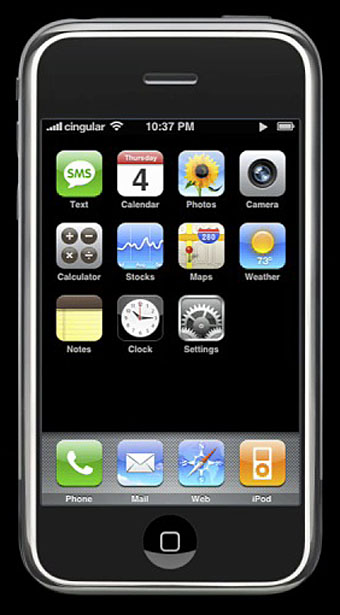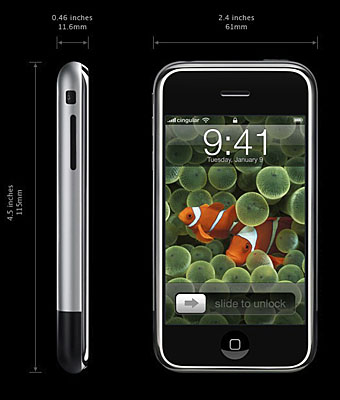Category: {technology}
Technology
The Complete New Yorker Portable Hard Drive
The Complete New Yorker Portable Hard Drive.
First the DVD, now the HD. 4,164 issues and 500,000+ pages.
Joost beta for Intel Macs
Joost beta for Intel Macs.
More web TV.
iPhone at last
So it arrived. Not much of a surprise after a year of “will they? won’t they?” but the combination phone + iPod + web device is certainly more than most people expected. New Apple products always feel like a little taste of the future and this is no exception. The touch-screen interface is very impressive indeed. The iPhone pages on Apple’s site have some nice demos of the interface at work, all of which look very familiar to users of the current Mac OS. In effect, it’s like OS X blended with the old iPod interface. I’m knocked out by the way they’ve given the iPod what amounts to iTunes in miniature, with the same Cover Flow feature for selecting albums. The web part of the device uses OS X apps Mail and Safari for email and web surfing (proper web pages as well, not WAP foolishness). And the way the screen display automatically switches from portrait to landscape when the phone is rotated is one of those gorgeous design elements at which Apple excels. I’ve been complaining about the interface on my Motorola since I got it; this machine is simply light years ahead. As for the wretched Zune, now looking even more like something designed by an overworked Soviet committee, I almost feel sorry for Microsoft after today (almost…).
Would I buy one of these? It’s very tempting even though it’ll have a heavy price (UK cost not announced yet) and probably be tied to a single carrier. They won’t be available in Europe until the end of the year anyway so there’s plenty of time to decide.
Dark Matter
Hubble Maps the Cosmic Web of “Clumpy” Dark Matter in 3-D
This three-dimensional map offers a first look at the web-like large-scale distribution of dark matter, an invisible form of matter that accounts for most of the universe’s mass. This milestone takes astronomers from inference to direct observation of dark matter’s influence in the universe. Because of the finite speed of light, regions furthest away are also seen as they existed a long time ago. The map stretches halfway back in time to the beginning of the universe.
The map reveals a loose network of dark matter filaments, gradually collapsing under the relentless pull of gravity, and growing clumpier over time. This confirms theories of how structure formed in our evolving universe, which has transitioned from a comparatively smooth distribution of matter at the time of the big bang. The dark matter filaments began to form first and provided an underlying scaffolding for the subsequent construction of stars and galaxies from ordinary matter. Without dark matter, there would have been insufficient mass in the universe for structures to collapse and galaxies to form.
[Top] – Three slices through the evolving distribution of dark matter. The dataset is created by splitting the background source galaxy population into discrete epochs of time (like cutting through geologic strata), looking back into the past. This is calibrated by measuring the cosmological redshift of the lensing galaxies used to map the dark matter distribution, and binning them into different time/distance “slices”. Each panel represents an area of sky nine times the angular diameter of the full Moon. Note that this fixed angle means that the survey volume is a really a cone, and that the physical area of the slices increases (from 19 Mpc on a side to 31 Mpc on a side) from left to right.
[Bottom] – When the slices across the universe and back into time are combined, they make a three-dimensional map of dark matter in the universe. The three axes of the box correspond to sky position (in right ascension and declination), and distance from the Earth increasing from left to right (as measured by cosmological redshift). Note how the clumping of the dark matter becomes more pronounced, moving right to left across the volume map, from the early universe to the more recent universe.
The dark matter distribution was mapped with Hubble Space Telescope’s largest ever survey of the universe, the Cosmic Evolution Survey (“COSMOS”). To compile the COSMOS survey, Hubble photographed 575 adjacent and slightly overlapping views of the universe using the Advanced Camera for Surveys’ (ACS) Wide Field Camera onboard Hubble. It took nearly 1,000 hours of observations. The distances to the galaxies were determined from their spectral redshifts, using the Subaru telescope in Hawaii.



